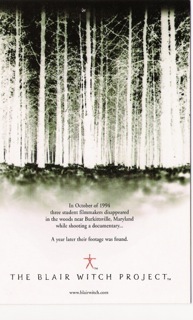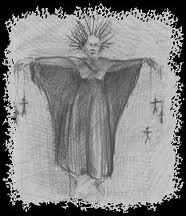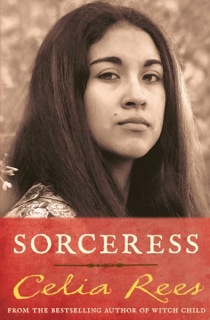SPOTLIGHT: Celia Rees on Inspiration
[image error]
When I was travelling in Wales recently, I found a copy of Celia Rees' book Witch Child in a bookshop in Hay-on-Wye. I'd always wanted to read this book and so I grabbed it at once, and read it that evening. It was perfect reading for a starlit night in that most magical of countries, and I was utterly transported and enchanted by this novel of a girl who is the daughter and grand-daughter of a witch and must struggle to find a place where she can be safe and true to herself.
So I am delighted to welcome Celia Rees to the blog today to talk about her inspirations for Witch Child:

One of the questions that Kate asks her guest authors is about inspiration.
It clearly has a universal fascination. ‘Where does your inspiration come from?’ is probably the question that I’m most commonly asked at any event whether I’m talking to adults or to children. The truth, as any author will tell you, is I don’t know and we don’t like to think about it too much. To do so might result in the wellspring drying up and we can’t risk that because inspiration is not a one off thing. It is an ongoing process. Yes, there’s that initial Big Idea, like a supernova going off in your head, but after that there will be, or should be, other moments almost as powerful.
Another of Kate’s questions concerns serendipity. Once you’ve had the Big Idea, sudden strange coincidences begin to occur. Synchronicities. Things begin to jump out at you, take on a sudden luminosity. You see something, hear something, that has huge relevance, that is new inspiration, that provides the catalyst, the essential element that will give that extra twist to your novel, make it more than just so, so.
These moments don’t come all that often and you can’t dial them up but, if you are lucky, they come when you need them. Such a one happened when I was writing Witch Child. I knew I had a good idea but I also knew that I needed something else, something more. Then I read about The Blair Witch Project.
The film wasn’t even showing in cinemas - just reading about the movie gave me a frisson of excitement. The story contained the vindicating elements that I look for when I’m writing historical fiction – this could have happened.
Everyone knows about the witch persecution in Salem, Massachusetts but I was looking for other, lesser known instances of the beliefs and fears that drove this kind of hysteria in Colonial America. The Blair Witch is based on The Bell Witch of Tennessee. That was vindication for me; the fear was there, in the woods, in the wilderness, in the minds of the European settlers.

But what I found really exciting was the premise of the film. That this was a true story. A film shot on handheld video camera by a group of students who had gone into the woods to research the Blair Witch and had disappeared. Only the video they’d shot remained. The ‘found’ document had been replaced by ‘found’ video footage. The film even had a website that contained all kinds of other stuff: a backstory of folklore and mythology, stained books, ‘Missing’ posters, interviews, T.V. news bulletins about the disappearances. This was made up, too, but it gave a documentary ring of truth that echoed and re-enforced the veracity of the ‘found’ film. I found the whole thing absolutely fascinating. It seemed to ask big questions about the very nature of fiction, about ways of telling, about what is real and what is not real and how do we know? If you Google Blair Witch, you will find that the debate goes on. The film has created its own mythology. I find this fascinating, too.

A novel is not just what the story is, it is how the story is told. For me, this narrative structuring is one of the most interesting aspects of fiction. Thinking about The Blair Witch Project, threw up intriguing possibilities about the novel I was writing. I’d already decided on a diary form and that the diary could be hidden in a quilt. OK, I thought, what if the quilt was found now and the diary was discovered during some kind of conservation process? What if the diary was then published? All it would need was a thin framing, an introduction from someone, let’s call her Alison Ellman, paper conservator, and an afterword from her asking for information, and an e mail address, why not? This would then act as a connection, a bridge, to the sequel Sorceress.

Witch Child would be a book (The Mary Papers) within a book. The Mary Papers hidden within a quilt and later discovered. Witch Child would be a story about a story. It would use the literary device of the 'found document', a tradition as old as the novel itself, as new as, well, The Blair Witch Project.
Sometimes you know when an idea is perfect. It slots right in, neat and tight, with no trouble whatsoever.
When I was travelling in Wales recently, I found a copy of Celia Rees' book Witch Child in a bookshop in Hay-on-Wye. I'd always wanted to read this book and so I grabbed it at once, and read it that evening. It was perfect reading for a starlit night in that most magical of countries, and I was utterly transported and enchanted by this novel of a girl who is the daughter and grand-daughter of a witch and must struggle to find a place where she can be safe and true to herself.
So I am delighted to welcome Celia Rees to the blog today to talk about her inspirations for Witch Child:

One of the questions that Kate asks her guest authors is about inspiration.
It clearly has a universal fascination. ‘Where does your inspiration come from?’ is probably the question that I’m most commonly asked at any event whether I’m talking to adults or to children. The truth, as any author will tell you, is I don’t know and we don’t like to think about it too much. To do so might result in the wellspring drying up and we can’t risk that because inspiration is not a one off thing. It is an ongoing process. Yes, there’s that initial Big Idea, like a supernova going off in your head, but after that there will be, or should be, other moments almost as powerful.
Another of Kate’s questions concerns serendipity. Once you’ve had the Big Idea, sudden strange coincidences begin to occur. Synchronicities. Things begin to jump out at you, take on a sudden luminosity. You see something, hear something, that has huge relevance, that is new inspiration, that provides the catalyst, the essential element that will give that extra twist to your novel, make it more than just so, so.
These moments don’t come all that often and you can’t dial them up but, if you are lucky, they come when you need them. Such a one happened when I was writing Witch Child. I knew I had a good idea but I also knew that I needed something else, something more. Then I read about The Blair Witch Project.
The film wasn’t even showing in cinemas - just reading about the movie gave me a frisson of excitement. The story contained the vindicating elements that I look for when I’m writing historical fiction – this could have happened.
Everyone knows about the witch persecution in Salem, Massachusetts but I was looking for other, lesser known instances of the beliefs and fears that drove this kind of hysteria in Colonial America. The Blair Witch is based on The Bell Witch of Tennessee. That was vindication for me; the fear was there, in the woods, in the wilderness, in the minds of the European settlers.

But what I found really exciting was the premise of the film. That this was a true story. A film shot on handheld video camera by a group of students who had gone into the woods to research the Blair Witch and had disappeared. Only the video they’d shot remained. The ‘found’ document had been replaced by ‘found’ video footage. The film even had a website that contained all kinds of other stuff: a backstory of folklore and mythology, stained books, ‘Missing’ posters, interviews, T.V. news bulletins about the disappearances. This was made up, too, but it gave a documentary ring of truth that echoed and re-enforced the veracity of the ‘found’ film. I found the whole thing absolutely fascinating. It seemed to ask big questions about the very nature of fiction, about ways of telling, about what is real and what is not real and how do we know? If you Google Blair Witch, you will find that the debate goes on. The film has created its own mythology. I find this fascinating, too.

A novel is not just what the story is, it is how the story is told. For me, this narrative structuring is one of the most interesting aspects of fiction. Thinking about The Blair Witch Project, threw up intriguing possibilities about the novel I was writing. I’d already decided on a diary form and that the diary could be hidden in a quilt. OK, I thought, what if the quilt was found now and the diary was discovered during some kind of conservation process? What if the diary was then published? All it would need was a thin framing, an introduction from someone, let’s call her Alison Ellman, paper conservator, and an afterword from her asking for information, and an e mail address, why not? This would then act as a connection, a bridge, to the sequel Sorceress.

Witch Child would be a book (The Mary Papers) within a book. The Mary Papers hidden within a quilt and later discovered. Witch Child would be a story about a story. It would use the literary device of the 'found document', a tradition as old as the novel itself, as new as, well, The Blair Witch Project.
Sometimes you know when an idea is perfect. It slots right in, neat and tight, with no trouble whatsoever.
Published on November 12, 2013 16:02
No comments have been added yet.



